8042NRS - Clinical Reasoning: Nursing Care of Post-PCI Patients
VerifiedAdded on 2023/06/12
|13
|4036
|474
Case Study
AI Summary
This case study focuses on the nursing care of Mr. Philemon Jones, a 74-year-old post-PCI patient, emphasizing the application of clinical reasoning. The case details Mr. Jones's medical history, including hypertension and a previous subdural hematoma, leading to a percutaneous coronary intervention (PCI) following unstable angina. The nursing care plan prioritizes monitoring vital signs, pain management, EKG monitoring, and early detection of complications like bleeding, hematoma, thromboembolism, arrhythmias, and restenosis. The assessment process involves a thorough history and physical examination, focusing on the femoral puncture site and systemic complications. Interventions include managing anticoagulant therapy, preventing thromboembolism, addressing arrhythmias, and educating the patient on medication adherence and potential side effects upon discharge. The study underscores the nurse's role in preventing complications, early identification of issues, and collaboration with the medical team to ensure optimal patient outcomes. Desklib offers a wealth of resources, including solved assignments and past papers, to aid students in their studies.
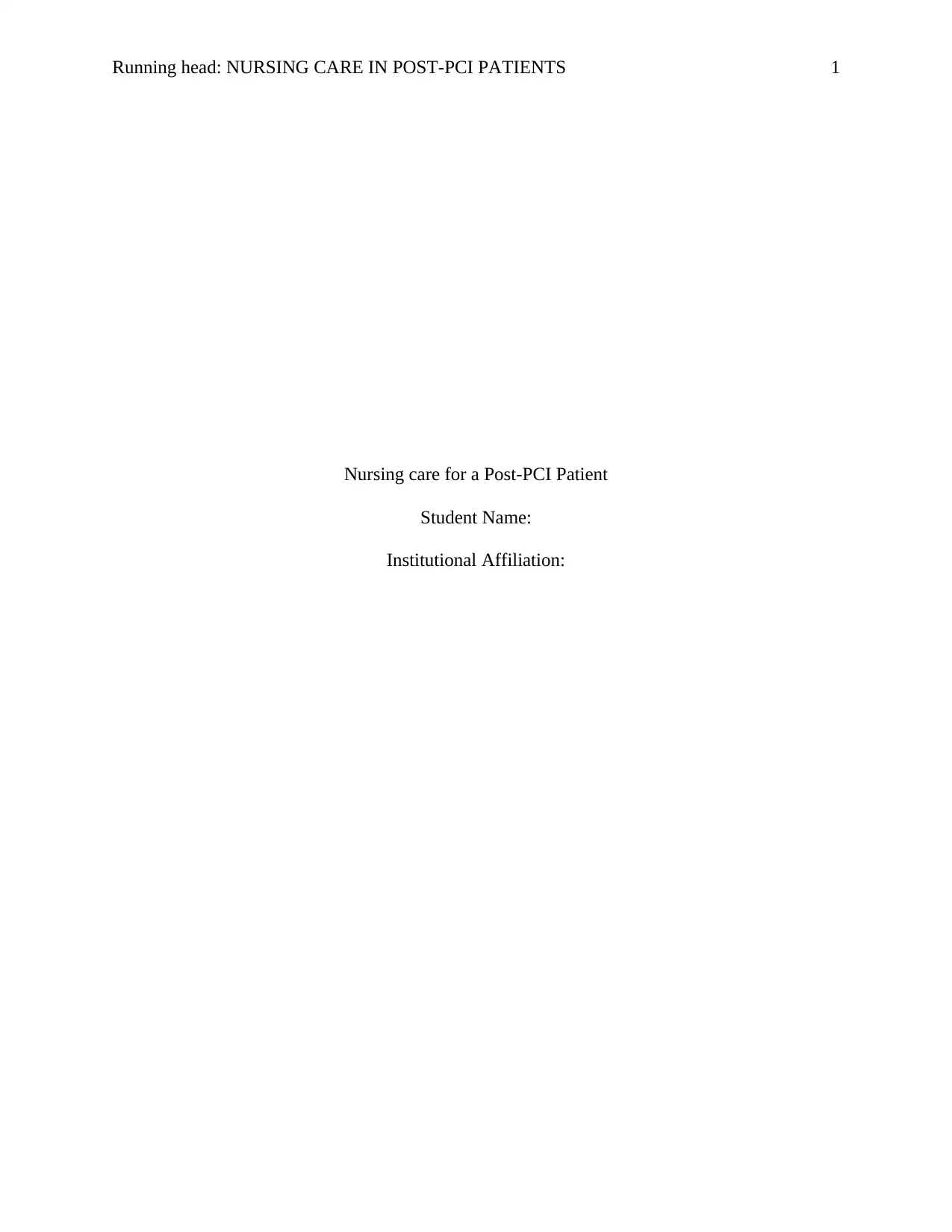
Running head: NURSING CARE IN POST-PCI PATIENTS 1
Nursing care for a Post-PCI Patient
Student Name:
Institutional Affiliation:
Nursing care for a Post-PCI Patient
Student Name:
Institutional Affiliation:
Paraphrase This Document
Need a fresh take? Get an instant paraphrase of this document with our AI Paraphraser

NURSING CARE IN POST-PCI PATIENTS 2
Nursing Care of a Post-PCI Patient
Introduction
The cardiovascular patient requiring nursing intervention is Mr. Philemon Jones. Mr.
Jones is a 74-year-old African-American man who came to the hospital 16 hours ago with
complaints of recurrent chest pain. The patient described the pain as squeezing and was located
in the center of the chest. The pain radiated to the left jaw and the left arm. He also stated that he
had had this pain several times before; the pain came after he engaged in strenuous activities like
gardening and was relieved when he took a rest. However, on this particular occasion, the pain
seemed to get worse even when he decided to rest. Lysing supine made the pain worse and
caused him to become breathless. He had used two sublingual tablets that his family doctor
prescribed to him but the pain had not subsided. He then took several tablets of aspirin before
calling his daughter who called the ambulance. Of significance, Mr. Jones is a known
hypertensive patient for the last 11 years on nifedipine. Mr. Jones also underwent an operation to
evacuate a left parietal subdural hematoma three years ago. The medical team saw the patient
immediately and made a diagnosis of an acute coronary syndrome. An Electrocardiogram (EKG)
done at admission ruled out myocardial infarction. A cardiac enzyme profile also emphasized
this finding. An echocardiogram conducted later showed hypertensive heart disease as evidenced
by left ventricular hypertrophy. The medical team thus determined that the patient had unstable
angina despite treatment with nifedipine, albeit for a different diagnosis altogether. They, thus,
decided to intervene. The medical team first arranged for a coronary angiography to detect any
narrowed segments in the coronary arteries; they determined partial occlusion of the circumflex
branch of the left coronary artery. They prepared for a percutaneous balloon coronary
angioplasty. In the operation, they used the left femoral artery to catheterize the patient. They
Nursing Care of a Post-PCI Patient
Introduction
The cardiovascular patient requiring nursing intervention is Mr. Philemon Jones. Mr.
Jones is a 74-year-old African-American man who came to the hospital 16 hours ago with
complaints of recurrent chest pain. The patient described the pain as squeezing and was located
in the center of the chest. The pain radiated to the left jaw and the left arm. He also stated that he
had had this pain several times before; the pain came after he engaged in strenuous activities like
gardening and was relieved when he took a rest. However, on this particular occasion, the pain
seemed to get worse even when he decided to rest. Lysing supine made the pain worse and
caused him to become breathless. He had used two sublingual tablets that his family doctor
prescribed to him but the pain had not subsided. He then took several tablets of aspirin before
calling his daughter who called the ambulance. Of significance, Mr. Jones is a known
hypertensive patient for the last 11 years on nifedipine. Mr. Jones also underwent an operation to
evacuate a left parietal subdural hematoma three years ago. The medical team saw the patient
immediately and made a diagnosis of an acute coronary syndrome. An Electrocardiogram (EKG)
done at admission ruled out myocardial infarction. A cardiac enzyme profile also emphasized
this finding. An echocardiogram conducted later showed hypertensive heart disease as evidenced
by left ventricular hypertrophy. The medical team thus determined that the patient had unstable
angina despite treatment with nifedipine, albeit for a different diagnosis altogether. They, thus,
decided to intervene. The medical team first arranged for a coronary angiography to detect any
narrowed segments in the coronary arteries; they determined partial occlusion of the circumflex
branch of the left coronary artery. They prepared for a percutaneous balloon coronary
angioplasty. In the operation, they used the left femoral artery to catheterize the patient. They
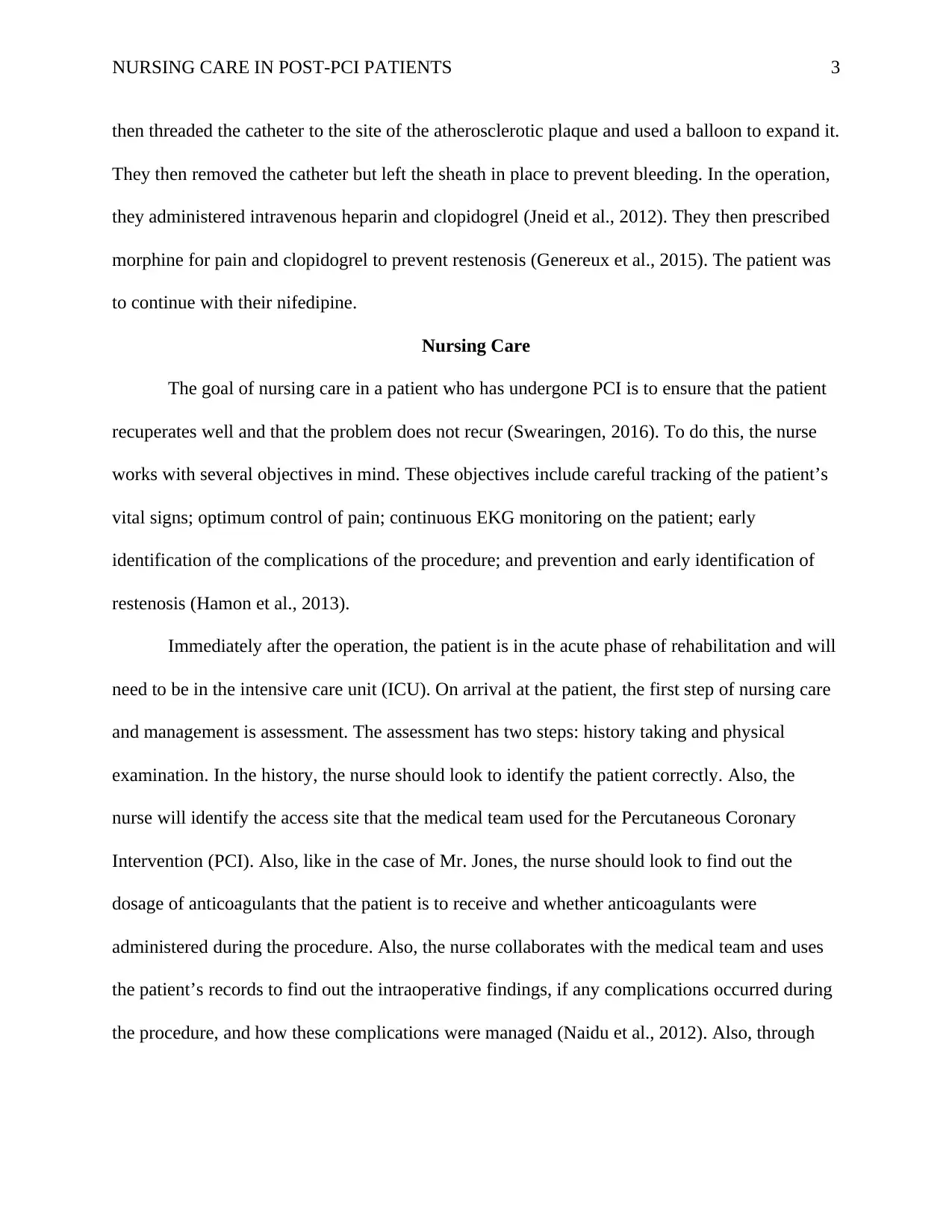
NURSING CARE IN POST-PCI PATIENTS 3
then threaded the catheter to the site of the atherosclerotic plaque and used a balloon to expand it.
They then removed the catheter but left the sheath in place to prevent bleeding. In the operation,
they administered intravenous heparin and clopidogrel (Jneid et al., 2012). They then prescribed
morphine for pain and clopidogrel to prevent restenosis (Genereux et al., 2015). The patient was
to continue with their nifedipine.
Nursing Care
The goal of nursing care in a patient who has undergone PCI is to ensure that the patient
recuperates well and that the problem does not recur (Swearingen, 2016). To do this, the nurse
works with several objectives in mind. These objectives include careful tracking of the patient’s
vital signs; optimum control of pain; continuous EKG monitoring on the patient; early
identification of the complications of the procedure; and prevention and early identification of
restenosis (Hamon et al., 2013).
Immediately after the operation, the patient is in the acute phase of rehabilitation and will
need to be in the intensive care unit (ICU). On arrival at the patient, the first step of nursing care
and management is assessment. The assessment has two steps: history taking and physical
examination. In the history, the nurse should look to identify the patient correctly. Also, the
nurse will identify the access site that the medical team used for the Percutaneous Coronary
Intervention (PCI). Also, like in the case of Mr. Jones, the nurse should look to find out the
dosage of anticoagulants that the patient is to receive and whether anticoagulants were
administered during the procedure. Also, the nurse collaborates with the medical team and uses
the patient’s records to find out the intraoperative findings, if any complications occurred during
the procedure, and how these complications were managed (Naidu et al., 2012). Also, through
then threaded the catheter to the site of the atherosclerotic plaque and used a balloon to expand it.
They then removed the catheter but left the sheath in place to prevent bleeding. In the operation,
they administered intravenous heparin and clopidogrel (Jneid et al., 2012). They then prescribed
morphine for pain and clopidogrel to prevent restenosis (Genereux et al., 2015). The patient was
to continue with their nifedipine.
Nursing Care
The goal of nursing care in a patient who has undergone PCI is to ensure that the patient
recuperates well and that the problem does not recur (Swearingen, 2016). To do this, the nurse
works with several objectives in mind. These objectives include careful tracking of the patient’s
vital signs; optimum control of pain; continuous EKG monitoring on the patient; early
identification of the complications of the procedure; and prevention and early identification of
restenosis (Hamon et al., 2013).
Immediately after the operation, the patient is in the acute phase of rehabilitation and will
need to be in the intensive care unit (ICU). On arrival at the patient, the first step of nursing care
and management is assessment. The assessment has two steps: history taking and physical
examination. In the history, the nurse should look to identify the patient correctly. Also, the
nurse will identify the access site that the medical team used for the Percutaneous Coronary
Intervention (PCI). Also, like in the case of Mr. Jones, the nurse should look to find out the
dosage of anticoagulants that the patient is to receive and whether anticoagulants were
administered during the procedure. Also, the nurse collaborates with the medical team and uses
the patient’s records to find out the intraoperative findings, if any complications occurred during
the procedure, and how these complications were managed (Naidu et al., 2012). Also, through
⊘ This is a preview!⊘
Do you want full access?
Subscribe today to unlock all pages.

Trusted by 1+ million students worldwide
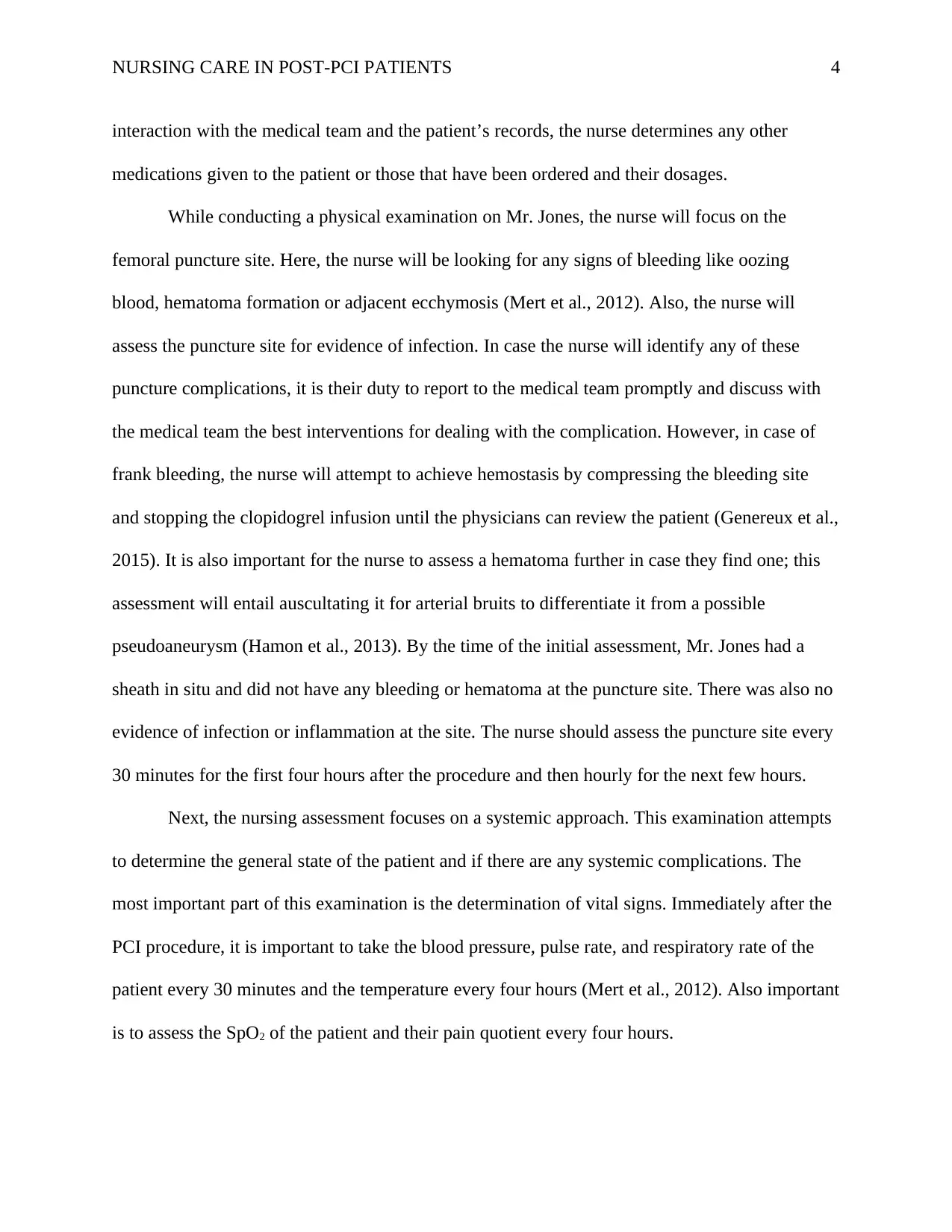
NURSING CARE IN POST-PCI PATIENTS 4
interaction with the medical team and the patient’s records, the nurse determines any other
medications given to the patient or those that have been ordered and their dosages.
While conducting a physical examination on Mr. Jones, the nurse will focus on the
femoral puncture site. Here, the nurse will be looking for any signs of bleeding like oozing
blood, hematoma formation or adjacent ecchymosis (Mert et al., 2012). Also, the nurse will
assess the puncture site for evidence of infection. In case the nurse will identify any of these
puncture complications, it is their duty to report to the medical team promptly and discuss with
the medical team the best interventions for dealing with the complication. However, in case of
frank bleeding, the nurse will attempt to achieve hemostasis by compressing the bleeding site
and stopping the clopidogrel infusion until the physicians can review the patient (Genereux et al.,
2015). It is also important for the nurse to assess a hematoma further in case they find one; this
assessment will entail auscultating it for arterial bruits to differentiate it from a possible
pseudoaneurysm (Hamon et al., 2013). By the time of the initial assessment, Mr. Jones had a
sheath in situ and did not have any bleeding or hematoma at the puncture site. There was also no
evidence of infection or inflammation at the site. The nurse should assess the puncture site every
30 minutes for the first four hours after the procedure and then hourly for the next few hours.
Next, the nursing assessment focuses on a systemic approach. This examination attempts
to determine the general state of the patient and if there are any systemic complications. The
most important part of this examination is the determination of vital signs. Immediately after the
PCI procedure, it is important to take the blood pressure, pulse rate, and respiratory rate of the
patient every 30 minutes and the temperature every four hours (Mert et al., 2012). Also important
is to assess the SpO2 of the patient and their pain quotient every four hours.
interaction with the medical team and the patient’s records, the nurse determines any other
medications given to the patient or those that have been ordered and their dosages.
While conducting a physical examination on Mr. Jones, the nurse will focus on the
femoral puncture site. Here, the nurse will be looking for any signs of bleeding like oozing
blood, hematoma formation or adjacent ecchymosis (Mert et al., 2012). Also, the nurse will
assess the puncture site for evidence of infection. In case the nurse will identify any of these
puncture complications, it is their duty to report to the medical team promptly and discuss with
the medical team the best interventions for dealing with the complication. However, in case of
frank bleeding, the nurse will attempt to achieve hemostasis by compressing the bleeding site
and stopping the clopidogrel infusion until the physicians can review the patient (Genereux et al.,
2015). It is also important for the nurse to assess a hematoma further in case they find one; this
assessment will entail auscultating it for arterial bruits to differentiate it from a possible
pseudoaneurysm (Hamon et al., 2013). By the time of the initial assessment, Mr. Jones had a
sheath in situ and did not have any bleeding or hematoma at the puncture site. There was also no
evidence of infection or inflammation at the site. The nurse should assess the puncture site every
30 minutes for the first four hours after the procedure and then hourly for the next few hours.
Next, the nursing assessment focuses on a systemic approach. This examination attempts
to determine the general state of the patient and if there are any systemic complications. The
most important part of this examination is the determination of vital signs. Immediately after the
PCI procedure, it is important to take the blood pressure, pulse rate, and respiratory rate of the
patient every 30 minutes and the temperature every four hours (Mert et al., 2012). Also important
is to assess the SpO2 of the patient and their pain quotient every four hours.
Paraphrase This Document
Need a fresh take? Get an instant paraphrase of this document with our AI Paraphraser
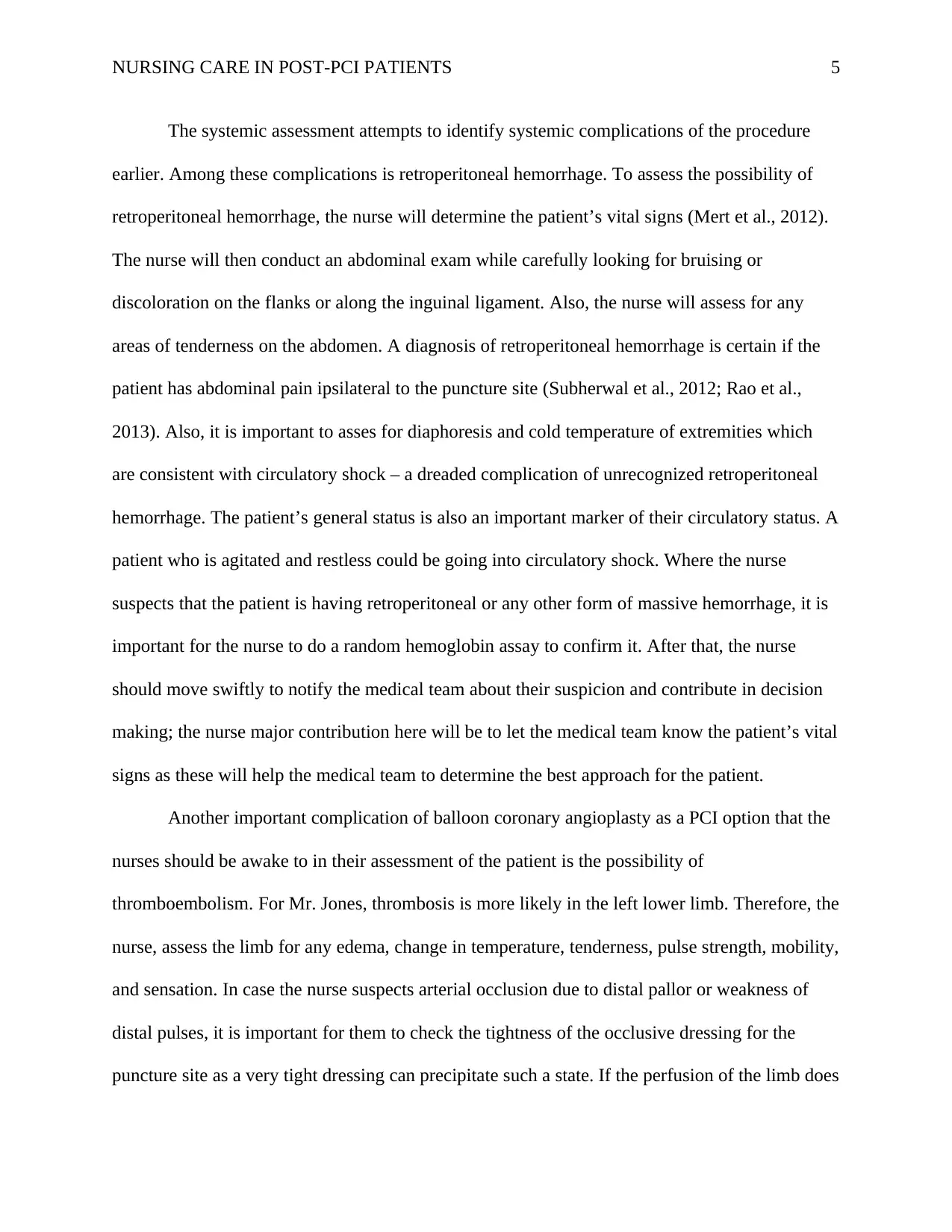
NURSING CARE IN POST-PCI PATIENTS 5
The systemic assessment attempts to identify systemic complications of the procedure
earlier. Among these complications is retroperitoneal hemorrhage. To assess the possibility of
retroperitoneal hemorrhage, the nurse will determine the patient’s vital signs (Mert et al., 2012).
The nurse will then conduct an abdominal exam while carefully looking for bruising or
discoloration on the flanks or along the inguinal ligament. Also, the nurse will assess for any
areas of tenderness on the abdomen. A diagnosis of retroperitoneal hemorrhage is certain if the
patient has abdominal pain ipsilateral to the puncture site (Subherwal et al., 2012; Rao et al.,
2013). Also, it is important to asses for diaphoresis and cold temperature of extremities which
are consistent with circulatory shock – a dreaded complication of unrecognized retroperitoneal
hemorrhage. The patient’s general status is also an important marker of their circulatory status. A
patient who is agitated and restless could be going into circulatory shock. Where the nurse
suspects that the patient is having retroperitoneal or any other form of massive hemorrhage, it is
important for the nurse to do a random hemoglobin assay to confirm it. After that, the nurse
should move swiftly to notify the medical team about their suspicion and contribute in decision
making; the nurse major contribution here will be to let the medical team know the patient’s vital
signs as these will help the medical team to determine the best approach for the patient.
Another important complication of balloon coronary angioplasty as a PCI option that the
nurses should be awake to in their assessment of the patient is the possibility of
thromboembolism. For Mr. Jones, thrombosis is more likely in the left lower limb. Therefore, the
nurse, assess the limb for any edema, change in temperature, tenderness, pulse strength, mobility,
and sensation. In case the nurse suspects arterial occlusion due to distal pallor or weakness of
distal pulses, it is important for them to check the tightness of the occlusive dressing for the
puncture site as a very tight dressing can precipitate such a state. If the perfusion of the limb does
The systemic assessment attempts to identify systemic complications of the procedure
earlier. Among these complications is retroperitoneal hemorrhage. To assess the possibility of
retroperitoneal hemorrhage, the nurse will determine the patient’s vital signs (Mert et al., 2012).
The nurse will then conduct an abdominal exam while carefully looking for bruising or
discoloration on the flanks or along the inguinal ligament. Also, the nurse will assess for any
areas of tenderness on the abdomen. A diagnosis of retroperitoneal hemorrhage is certain if the
patient has abdominal pain ipsilateral to the puncture site (Subherwal et al., 2012; Rao et al.,
2013). Also, it is important to asses for diaphoresis and cold temperature of extremities which
are consistent with circulatory shock – a dreaded complication of unrecognized retroperitoneal
hemorrhage. The patient’s general status is also an important marker of their circulatory status. A
patient who is agitated and restless could be going into circulatory shock. Where the nurse
suspects that the patient is having retroperitoneal or any other form of massive hemorrhage, it is
important for the nurse to do a random hemoglobin assay to confirm it. After that, the nurse
should move swiftly to notify the medical team about their suspicion and contribute in decision
making; the nurse major contribution here will be to let the medical team know the patient’s vital
signs as these will help the medical team to determine the best approach for the patient.
Another important complication of balloon coronary angioplasty as a PCI option that the
nurses should be awake to in their assessment of the patient is the possibility of
thromboembolism. For Mr. Jones, thrombosis is more likely in the left lower limb. Therefore, the
nurse, assess the limb for any edema, change in temperature, tenderness, pulse strength, mobility,
and sensation. In case the nurse suspects arterial occlusion due to distal pallor or weakness of
distal pulses, it is important for them to check the tightness of the occlusive dressing for the
puncture site as a very tight dressing can precipitate such a state. If the perfusion of the limb does
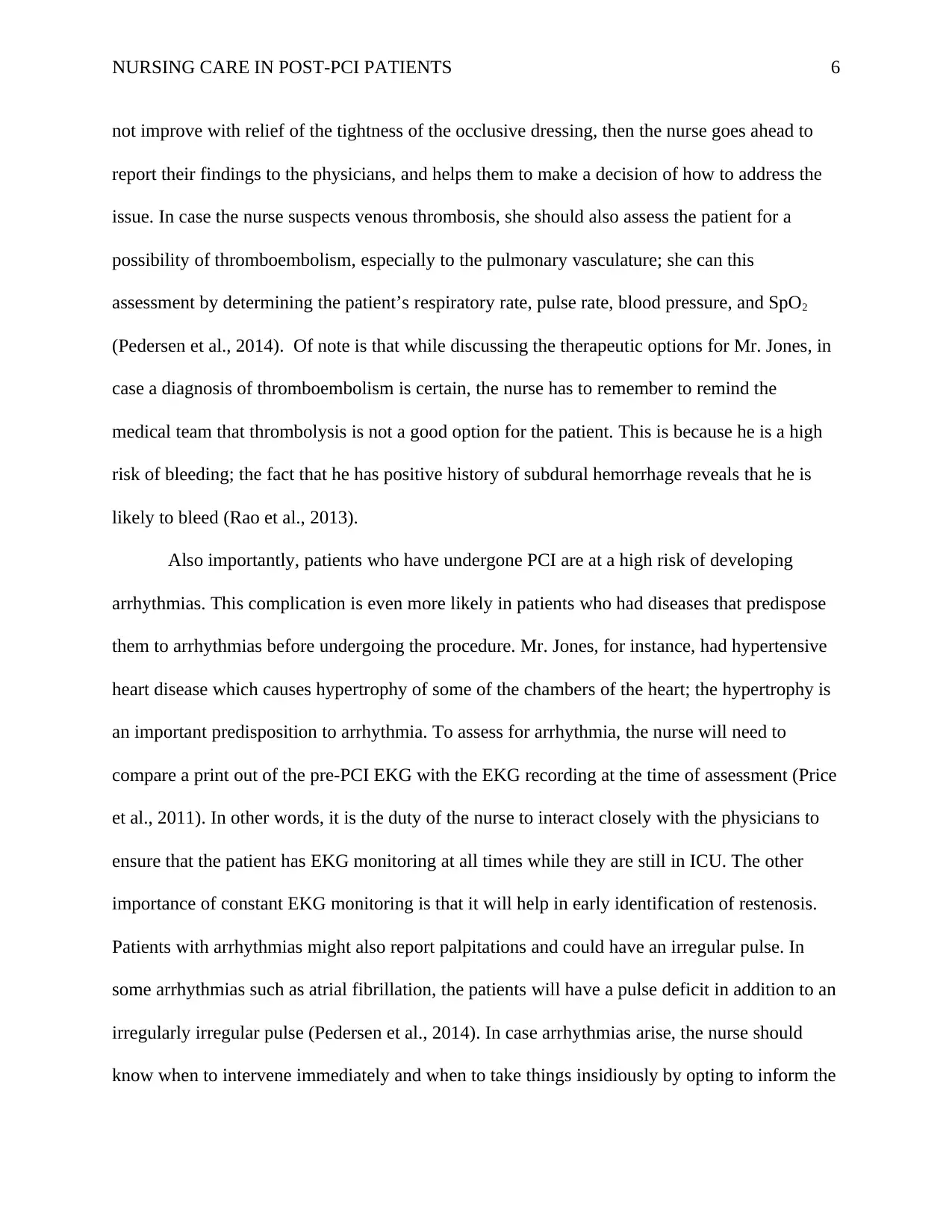
NURSING CARE IN POST-PCI PATIENTS 6
not improve with relief of the tightness of the occlusive dressing, then the nurse goes ahead to
report their findings to the physicians, and helps them to make a decision of how to address the
issue. In case the nurse suspects venous thrombosis, she should also assess the patient for a
possibility of thromboembolism, especially to the pulmonary vasculature; she can this
assessment by determining the patient’s respiratory rate, pulse rate, blood pressure, and SpO2
(Pedersen et al., 2014). Of note is that while discussing the therapeutic options for Mr. Jones, in
case a diagnosis of thromboembolism is certain, the nurse has to remember to remind the
medical team that thrombolysis is not a good option for the patient. This is because he is a high
risk of bleeding; the fact that he has positive history of subdural hemorrhage reveals that he is
likely to bleed (Rao et al., 2013).
Also importantly, patients who have undergone PCI are at a high risk of developing
arrhythmias. This complication is even more likely in patients who had diseases that predispose
them to arrhythmias before undergoing the procedure. Mr. Jones, for instance, had hypertensive
heart disease which causes hypertrophy of some of the chambers of the heart; the hypertrophy is
an important predisposition to arrhythmia. To assess for arrhythmia, the nurse will need to
compare a print out of the pre-PCI EKG with the EKG recording at the time of assessment (Price
et al., 2011). In other words, it is the duty of the nurse to interact closely with the physicians to
ensure that the patient has EKG monitoring at all times while they are still in ICU. The other
importance of constant EKG monitoring is that it will help in early identification of restenosis.
Patients with arrhythmias might also report palpitations and could have an irregular pulse. In
some arrhythmias such as atrial fibrillation, the patients will have a pulse deficit in addition to an
irregularly irregular pulse (Pedersen et al., 2014). In case arrhythmias arise, the nurse should
know when to intervene immediately and when to take things insidiously by opting to inform the
not improve with relief of the tightness of the occlusive dressing, then the nurse goes ahead to
report their findings to the physicians, and helps them to make a decision of how to address the
issue. In case the nurse suspects venous thrombosis, she should also assess the patient for a
possibility of thromboembolism, especially to the pulmonary vasculature; she can this
assessment by determining the patient’s respiratory rate, pulse rate, blood pressure, and SpO2
(Pedersen et al., 2014). Of note is that while discussing the therapeutic options for Mr. Jones, in
case a diagnosis of thromboembolism is certain, the nurse has to remember to remind the
medical team that thrombolysis is not a good option for the patient. This is because he is a high
risk of bleeding; the fact that he has positive history of subdural hemorrhage reveals that he is
likely to bleed (Rao et al., 2013).
Also importantly, patients who have undergone PCI are at a high risk of developing
arrhythmias. This complication is even more likely in patients who had diseases that predispose
them to arrhythmias before undergoing the procedure. Mr. Jones, for instance, had hypertensive
heart disease which causes hypertrophy of some of the chambers of the heart; the hypertrophy is
an important predisposition to arrhythmia. To assess for arrhythmia, the nurse will need to
compare a print out of the pre-PCI EKG with the EKG recording at the time of assessment (Price
et al., 2011). In other words, it is the duty of the nurse to interact closely with the physicians to
ensure that the patient has EKG monitoring at all times while they are still in ICU. The other
importance of constant EKG monitoring is that it will help in early identification of restenosis.
Patients with arrhythmias might also report palpitations and could have an irregular pulse. In
some arrhythmias such as atrial fibrillation, the patients will have a pulse deficit in addition to an
irregularly irregular pulse (Pedersen et al., 2014). In case arrhythmias arise, the nurse should
know when to intervene immediately and when to take things insidiously by opting to inform the
⊘ This is a preview!⊘
Do you want full access?
Subscribe today to unlock all pages.

Trusted by 1+ million students worldwide
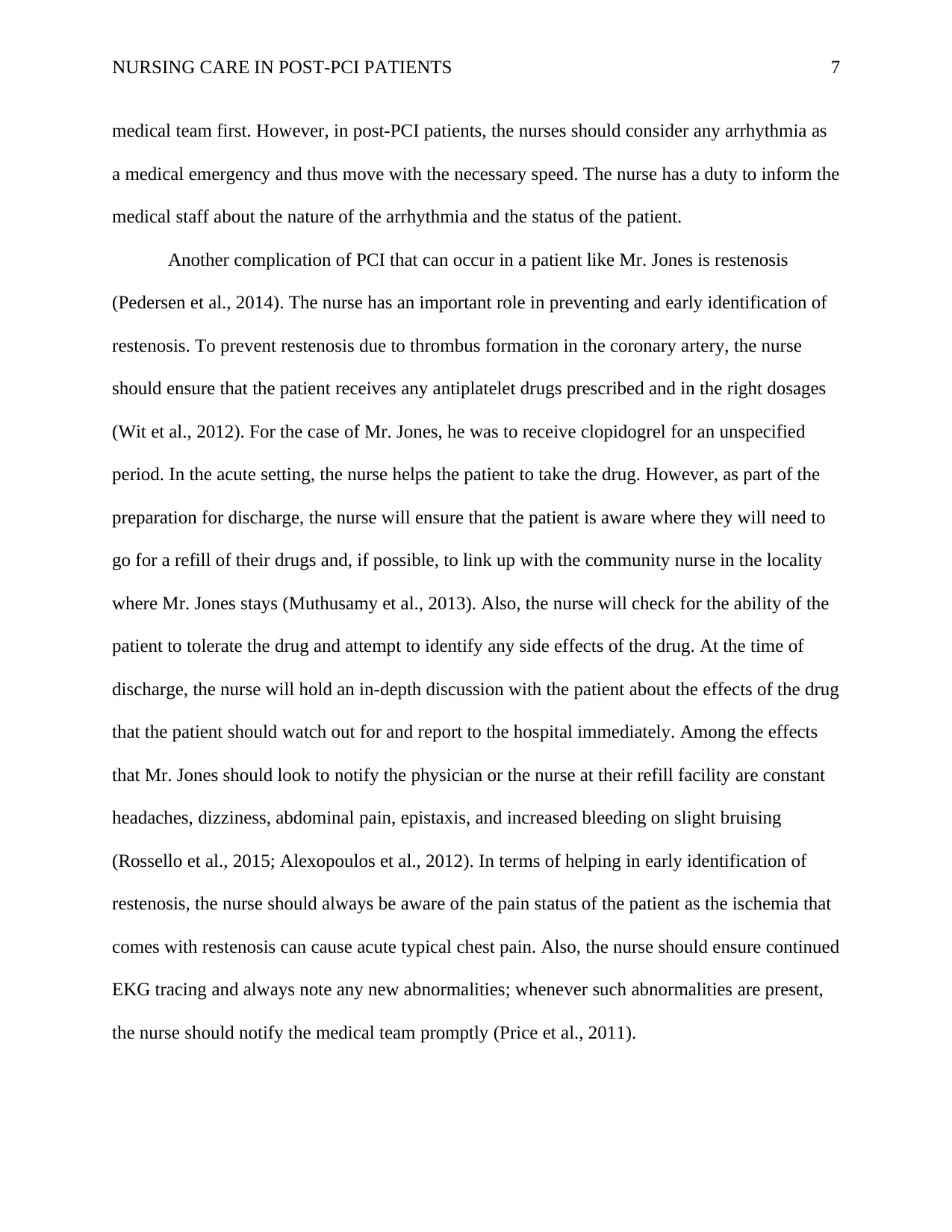
NURSING CARE IN POST-PCI PATIENTS 7
medical team first. However, in post-PCI patients, the nurses should consider any arrhythmia as
a medical emergency and thus move with the necessary speed. The nurse has a duty to inform the
medical staff about the nature of the arrhythmia and the status of the patient.
Another complication of PCI that can occur in a patient like Mr. Jones is restenosis
(Pedersen et al., 2014). The nurse has an important role in preventing and early identification of
restenosis. To prevent restenosis due to thrombus formation in the coronary artery, the nurse
should ensure that the patient receives any antiplatelet drugs prescribed and in the right dosages
(Wit et al., 2012). For the case of Mr. Jones, he was to receive clopidogrel for an unspecified
period. In the acute setting, the nurse helps the patient to take the drug. However, as part of the
preparation for discharge, the nurse will ensure that the patient is aware where they will need to
go for a refill of their drugs and, if possible, to link up with the community nurse in the locality
where Mr. Jones stays (Muthusamy et al., 2013). Also, the nurse will check for the ability of the
patient to tolerate the drug and attempt to identify any side effects of the drug. At the time of
discharge, the nurse will hold an in-depth discussion with the patient about the effects of the drug
that the patient should watch out for and report to the hospital immediately. Among the effects
that Mr. Jones should look to notify the physician or the nurse at their refill facility are constant
headaches, dizziness, abdominal pain, epistaxis, and increased bleeding on slight bruising
(Rossello et al., 2015; Alexopoulos et al., 2012). In terms of helping in early identification of
restenosis, the nurse should always be aware of the pain status of the patient as the ischemia that
comes with restenosis can cause acute typical chest pain. Also, the nurse should ensure continued
EKG tracing and always note any new abnormalities; whenever such abnormalities are present,
the nurse should notify the medical team promptly (Price et al., 2011).
medical team first. However, in post-PCI patients, the nurses should consider any arrhythmia as
a medical emergency and thus move with the necessary speed. The nurse has a duty to inform the
medical staff about the nature of the arrhythmia and the status of the patient.
Another complication of PCI that can occur in a patient like Mr. Jones is restenosis
(Pedersen et al., 2014). The nurse has an important role in preventing and early identification of
restenosis. To prevent restenosis due to thrombus formation in the coronary artery, the nurse
should ensure that the patient receives any antiplatelet drugs prescribed and in the right dosages
(Wit et al., 2012). For the case of Mr. Jones, he was to receive clopidogrel for an unspecified
period. In the acute setting, the nurse helps the patient to take the drug. However, as part of the
preparation for discharge, the nurse will ensure that the patient is aware where they will need to
go for a refill of their drugs and, if possible, to link up with the community nurse in the locality
where Mr. Jones stays (Muthusamy et al., 2013). Also, the nurse will check for the ability of the
patient to tolerate the drug and attempt to identify any side effects of the drug. At the time of
discharge, the nurse will hold an in-depth discussion with the patient about the effects of the drug
that the patient should watch out for and report to the hospital immediately. Among the effects
that Mr. Jones should look to notify the physician or the nurse at their refill facility are constant
headaches, dizziness, abdominal pain, epistaxis, and increased bleeding on slight bruising
(Rossello et al., 2015; Alexopoulos et al., 2012). In terms of helping in early identification of
restenosis, the nurse should always be aware of the pain status of the patient as the ischemia that
comes with restenosis can cause acute typical chest pain. Also, the nurse should ensure continued
EKG tracing and always note any new abnormalities; whenever such abnormalities are present,
the nurse should notify the medical team promptly (Price et al., 2011).
Paraphrase This Document
Need a fresh take? Get an instant paraphrase of this document with our AI Paraphraser
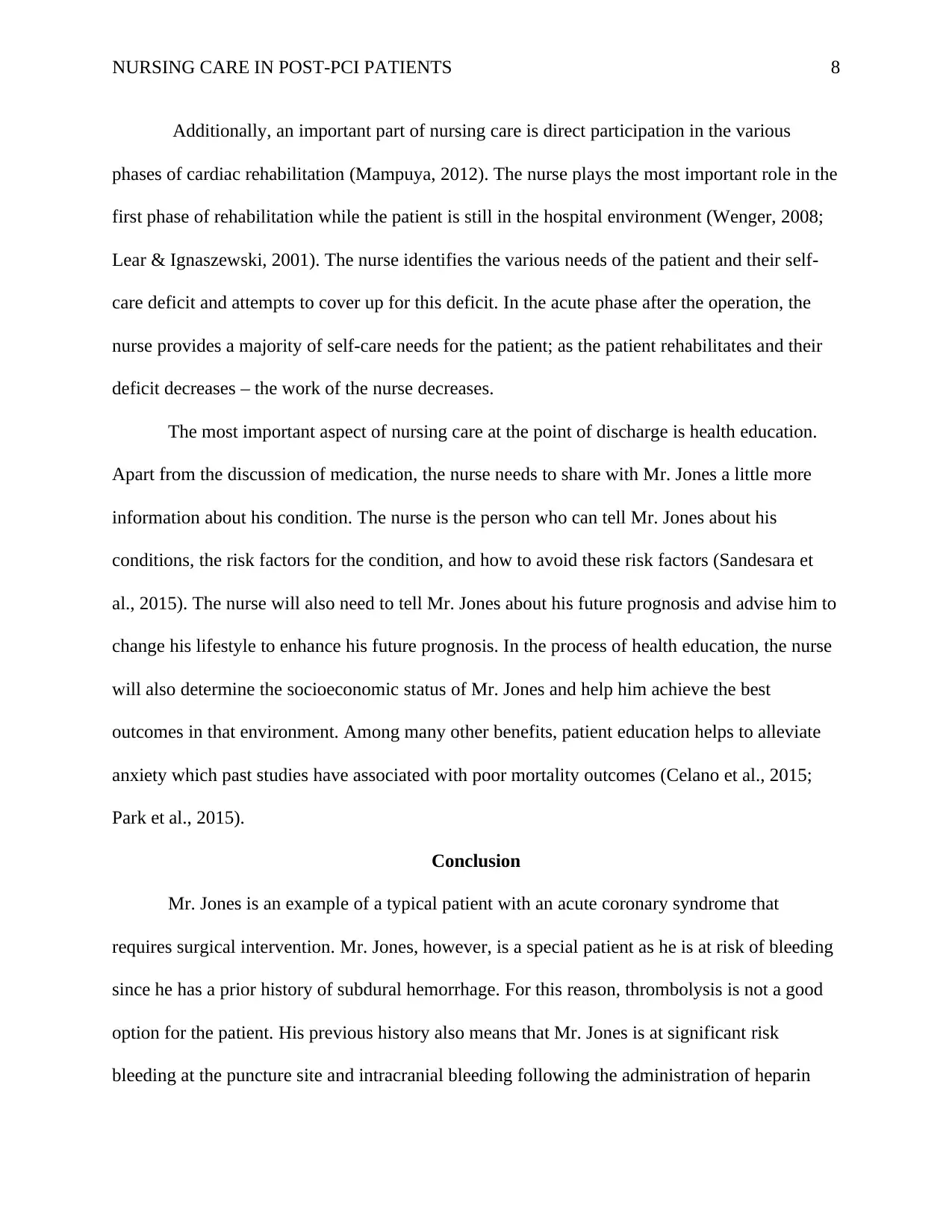
NURSING CARE IN POST-PCI PATIENTS 8
Additionally, an important part of nursing care is direct participation in the various
phases of cardiac rehabilitation (Mampuya, 2012). The nurse plays the most important role in the
first phase of rehabilitation while the patient is still in the hospital environment (Wenger, 2008;
Lear & Ignaszewski, 2001). The nurse identifies the various needs of the patient and their self-
care deficit and attempts to cover up for this deficit. In the acute phase after the operation, the
nurse provides a majority of self-care needs for the patient; as the patient rehabilitates and their
deficit decreases – the work of the nurse decreases.
The most important aspect of nursing care at the point of discharge is health education.
Apart from the discussion of medication, the nurse needs to share with Mr. Jones a little more
information about his condition. The nurse is the person who can tell Mr. Jones about his
conditions, the risk factors for the condition, and how to avoid these risk factors (Sandesara et
al., 2015). The nurse will also need to tell Mr. Jones about his future prognosis and advise him to
change his lifestyle to enhance his future prognosis. In the process of health education, the nurse
will also determine the socioeconomic status of Mr. Jones and help him achieve the best
outcomes in that environment. Among many other benefits, patient education helps to alleviate
anxiety which past studies have associated with poor mortality outcomes (Celano et al., 2015;
Park et al., 2015).
Conclusion
Mr. Jones is an example of a typical patient with an acute coronary syndrome that
requires surgical intervention. Mr. Jones, however, is a special patient as he is at risk of bleeding
since he has a prior history of subdural hemorrhage. For this reason, thrombolysis is not a good
option for the patient. His previous history also means that Mr. Jones is at significant risk
bleeding at the puncture site and intracranial bleeding following the administration of heparin
Additionally, an important part of nursing care is direct participation in the various
phases of cardiac rehabilitation (Mampuya, 2012). The nurse plays the most important role in the
first phase of rehabilitation while the patient is still in the hospital environment (Wenger, 2008;
Lear & Ignaszewski, 2001). The nurse identifies the various needs of the patient and their self-
care deficit and attempts to cover up for this deficit. In the acute phase after the operation, the
nurse provides a majority of self-care needs for the patient; as the patient rehabilitates and their
deficit decreases – the work of the nurse decreases.
The most important aspect of nursing care at the point of discharge is health education.
Apart from the discussion of medication, the nurse needs to share with Mr. Jones a little more
information about his condition. The nurse is the person who can tell Mr. Jones about his
conditions, the risk factors for the condition, and how to avoid these risk factors (Sandesara et
al., 2015). The nurse will also need to tell Mr. Jones about his future prognosis and advise him to
change his lifestyle to enhance his future prognosis. In the process of health education, the nurse
will also determine the socioeconomic status of Mr. Jones and help him achieve the best
outcomes in that environment. Among many other benefits, patient education helps to alleviate
anxiety which past studies have associated with poor mortality outcomes (Celano et al., 2015;
Park et al., 2015).
Conclusion
Mr. Jones is an example of a typical patient with an acute coronary syndrome that
requires surgical intervention. Mr. Jones, however, is a special patient as he is at risk of bleeding
since he has a prior history of subdural hemorrhage. For this reason, thrombolysis is not a good
option for the patient. His previous history also means that Mr. Jones is at significant risk
bleeding at the puncture site and intracranial bleeding following the administration of heparin
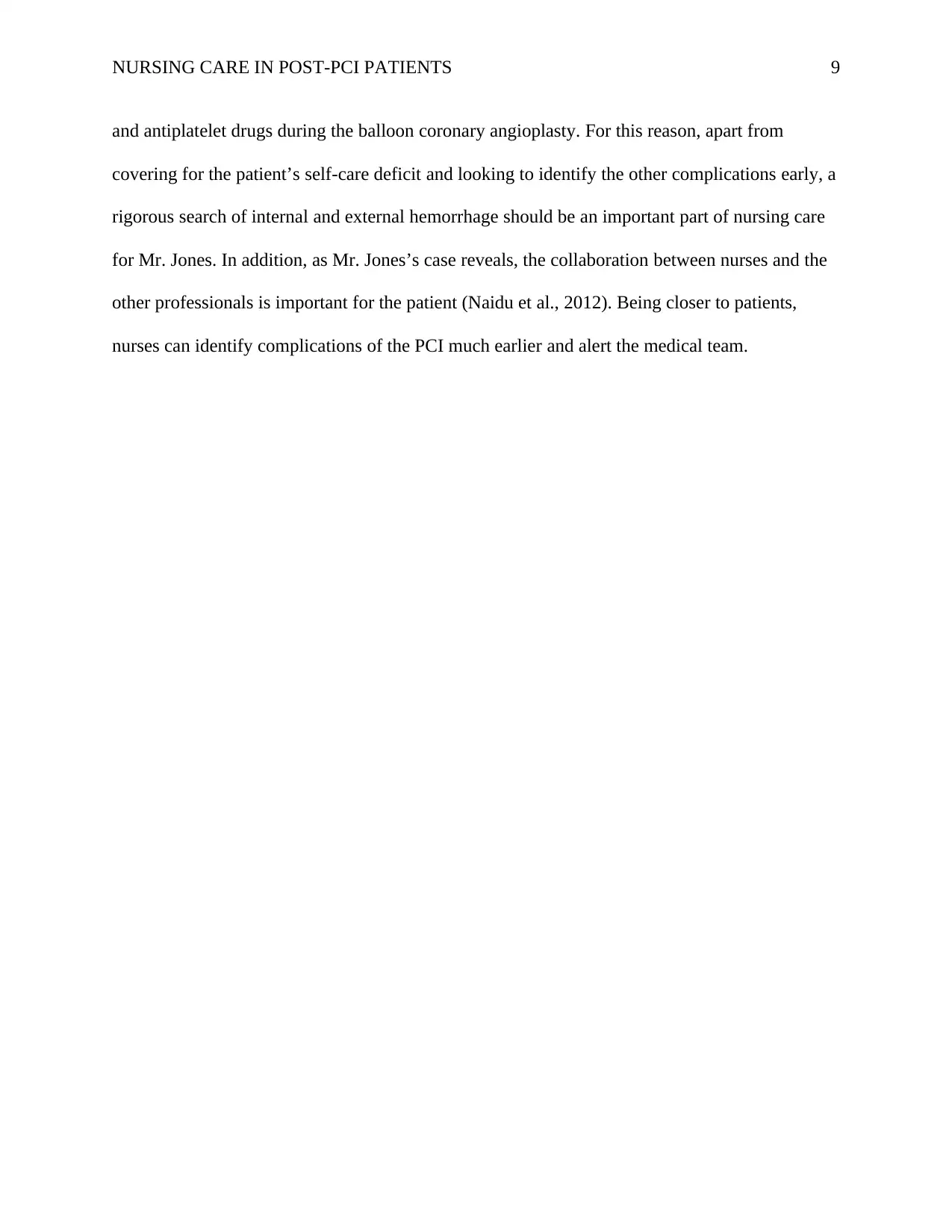
NURSING CARE IN POST-PCI PATIENTS 9
and antiplatelet drugs during the balloon coronary angioplasty. For this reason, apart from
covering for the patient’s self-care deficit and looking to identify the other complications early, a
rigorous search of internal and external hemorrhage should be an important part of nursing care
for Mr. Jones. In addition, as Mr. Jones’s case reveals, the collaboration between nurses and the
other professionals is important for the patient (Naidu et al., 2012). Being closer to patients,
nurses can identify complications of the PCI much earlier and alert the medical team.
and antiplatelet drugs during the balloon coronary angioplasty. For this reason, apart from
covering for the patient’s self-care deficit and looking to identify the other complications early, a
rigorous search of internal and external hemorrhage should be an important part of nursing care
for Mr. Jones. In addition, as Mr. Jones’s case reveals, the collaboration between nurses and the
other professionals is important for the patient (Naidu et al., 2012). Being closer to patients,
nurses can identify complications of the PCI much earlier and alert the medical team.
⊘ This is a preview!⊘
Do you want full access?
Subscribe today to unlock all pages.

Trusted by 1+ million students worldwide
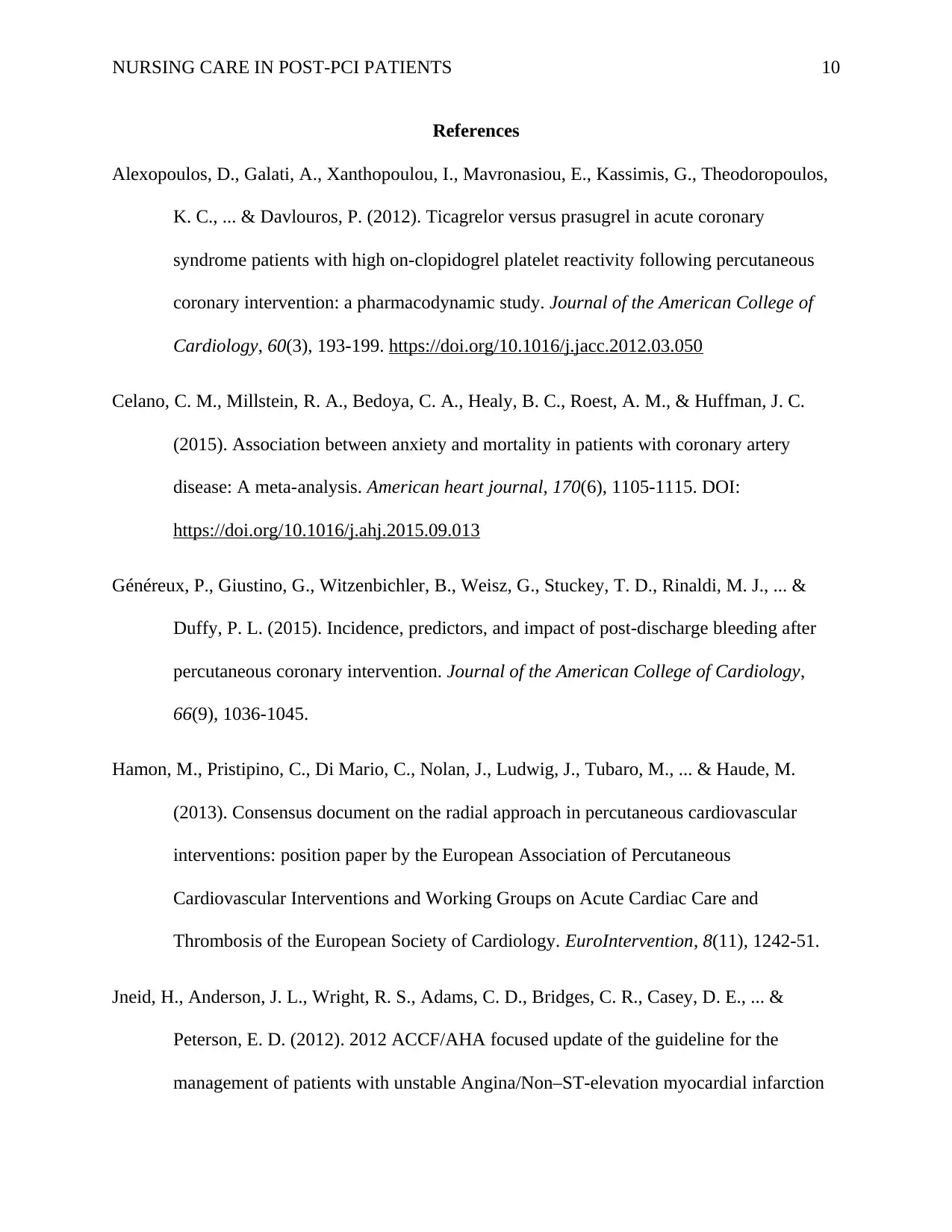
NURSING CARE IN POST-PCI PATIENTS 10
References
Alexopoulos, D., Galati, A., Xanthopoulou, I., Mavronasiou, E., Kassimis, G., Theodoropoulos,
K. C., ... & Davlouros, P. (2012). Ticagrelor versus prasugrel in acute coronary
syndrome patients with high on-clopidogrel platelet reactivity following percutaneous
coronary intervention: a pharmacodynamic study. Journal of the American College of
Cardiology, 60(3), 193-199. https://doi.org/10.1016/j.jacc.2012.03.050
Celano, C. M., Millstein, R. A., Bedoya, C. A., Healy, B. C., Roest, A. M., & Huffman, J. C.
(2015). Association between anxiety and mortality in patients with coronary artery
disease: A meta-analysis. American heart journal, 170(6), 1105-1115. DOI:
https://doi.org/10.1016/j.ahj.2015.09.013
Généreux, P., Giustino, G., Witzenbichler, B., Weisz, G., Stuckey, T. D., Rinaldi, M. J., ... &
Duffy, P. L. (2015). Incidence, predictors, and impact of post-discharge bleeding after
percutaneous coronary intervention. Journal of the American College of Cardiology,
66(9), 1036-1045.
Hamon, M., Pristipino, C., Di Mario, C., Nolan, J., Ludwig, J., Tubaro, M., ... & Haude, M.
(2013). Consensus document on the radial approach in percutaneous cardiovascular
interventions: position paper by the European Association of Percutaneous
Cardiovascular Interventions and Working Groups on Acute Cardiac Care and
Thrombosis of the European Society of Cardiology. EuroIntervention, 8(11), 1242-51.
Jneid, H., Anderson, J. L., Wright, R. S., Adams, C. D., Bridges, C. R., Casey, D. E., ... &
Peterson, E. D. (2012). 2012 ACCF/AHA focused update of the guideline for the
management of patients with unstable Angina/Non–ST-elevation myocardial infarction
References
Alexopoulos, D., Galati, A., Xanthopoulou, I., Mavronasiou, E., Kassimis, G., Theodoropoulos,
K. C., ... & Davlouros, P. (2012). Ticagrelor versus prasugrel in acute coronary
syndrome patients with high on-clopidogrel platelet reactivity following percutaneous
coronary intervention: a pharmacodynamic study. Journal of the American College of
Cardiology, 60(3), 193-199. https://doi.org/10.1016/j.jacc.2012.03.050
Celano, C. M., Millstein, R. A., Bedoya, C. A., Healy, B. C., Roest, A. M., & Huffman, J. C.
(2015). Association between anxiety and mortality in patients with coronary artery
disease: A meta-analysis. American heart journal, 170(6), 1105-1115. DOI:
https://doi.org/10.1016/j.ahj.2015.09.013
Généreux, P., Giustino, G., Witzenbichler, B., Weisz, G., Stuckey, T. D., Rinaldi, M. J., ... &
Duffy, P. L. (2015). Incidence, predictors, and impact of post-discharge bleeding after
percutaneous coronary intervention. Journal of the American College of Cardiology,
66(9), 1036-1045.
Hamon, M., Pristipino, C., Di Mario, C., Nolan, J., Ludwig, J., Tubaro, M., ... & Haude, M.
(2013). Consensus document on the radial approach in percutaneous cardiovascular
interventions: position paper by the European Association of Percutaneous
Cardiovascular Interventions and Working Groups on Acute Cardiac Care and
Thrombosis of the European Society of Cardiology. EuroIntervention, 8(11), 1242-51.
Jneid, H., Anderson, J. L., Wright, R. S., Adams, C. D., Bridges, C. R., Casey, D. E., ... &
Peterson, E. D. (2012). 2012 ACCF/AHA focused update of the guideline for the
management of patients with unstable Angina/Non–ST-elevation myocardial infarction
Paraphrase This Document
Need a fresh take? Get an instant paraphrase of this document with our AI Paraphraser

NURSING CARE IN POST-PCI PATIENTS 11
(updating the 2007 guideline and replacing the 2011 focused update). Circulation,
126(7), 875-910. https://doi.org/10.1161/CIR.0b013e318256f1e0
Lear, S. A., & Ignaszewski, A. (2001). Cardiac rehabilitation: a comprehensive review. Trials,
2(5), 221. https://doi.org/10.1186/cvm-2-5-221
Mampuya, W. M. (2012). Cardiac rehabilitation past, present and future: an overview.
Cardiovascular diagnosis and therapy, 2(1), 38. doi: 10.3978/j.issn.2223-
3652.2012.01.02
Mert, H., Seren Intepeler, S., Bengu, N., Baturlar, Z., Istan, P., & Ozcelik, E. (2012). Efficacy of
frequent blood pressure and heart rate monitoring for early identification of bleeding
following percutaneous coronary intervention. International journal of nursing practice,
18(1), 52-59.
Muthusamy, P., Busman, D. K., Davis, A. T., & Wohns, D. H. (2013). Assessment of clinical
outcomes related to early discharge after elective percutaneous coronary intervention.
Catheterization and Cardiovascular Interventions, 81(1), 6-13.
https://doi.org/10.1002/ccd.24537
Naidu, S. S., Rao, S. V., Blankenship, J., Cavendish, J. J., Farah, T., Moussa, I., ... & Yakubov,
S. J. (2012). Clinical expert consensus statement on best practices in the cardiac
catheterization laboratory: Society for Cardiovascular Angiography and Interventions.
Catheterization and Cardiovascular Interventions, 80(3), 456-464.
https://doi.org/10.1002/ccd.24311
(updating the 2007 guideline and replacing the 2011 focused update). Circulation,
126(7), 875-910. https://doi.org/10.1161/CIR.0b013e318256f1e0
Lear, S. A., & Ignaszewski, A. (2001). Cardiac rehabilitation: a comprehensive review. Trials,
2(5), 221. https://doi.org/10.1186/cvm-2-5-221
Mampuya, W. M. (2012). Cardiac rehabilitation past, present and future: an overview.
Cardiovascular diagnosis and therapy, 2(1), 38. doi: 10.3978/j.issn.2223-
3652.2012.01.02
Mert, H., Seren Intepeler, S., Bengu, N., Baturlar, Z., Istan, P., & Ozcelik, E. (2012). Efficacy of
frequent blood pressure and heart rate monitoring for early identification of bleeding
following percutaneous coronary intervention. International journal of nursing practice,
18(1), 52-59.
Muthusamy, P., Busman, D. K., Davis, A. T., & Wohns, D. H. (2013). Assessment of clinical
outcomes related to early discharge after elective percutaneous coronary intervention.
Catheterization and Cardiovascular Interventions, 81(1), 6-13.
https://doi.org/10.1002/ccd.24537
Naidu, S. S., Rao, S. V., Blankenship, J., Cavendish, J. J., Farah, T., Moussa, I., ... & Yakubov,
S. J. (2012). Clinical expert consensus statement on best practices in the cardiac
catheterization laboratory: Society for Cardiovascular Angiography and Interventions.
Catheterization and Cardiovascular Interventions, 80(3), 456-464.
https://doi.org/10.1002/ccd.24311
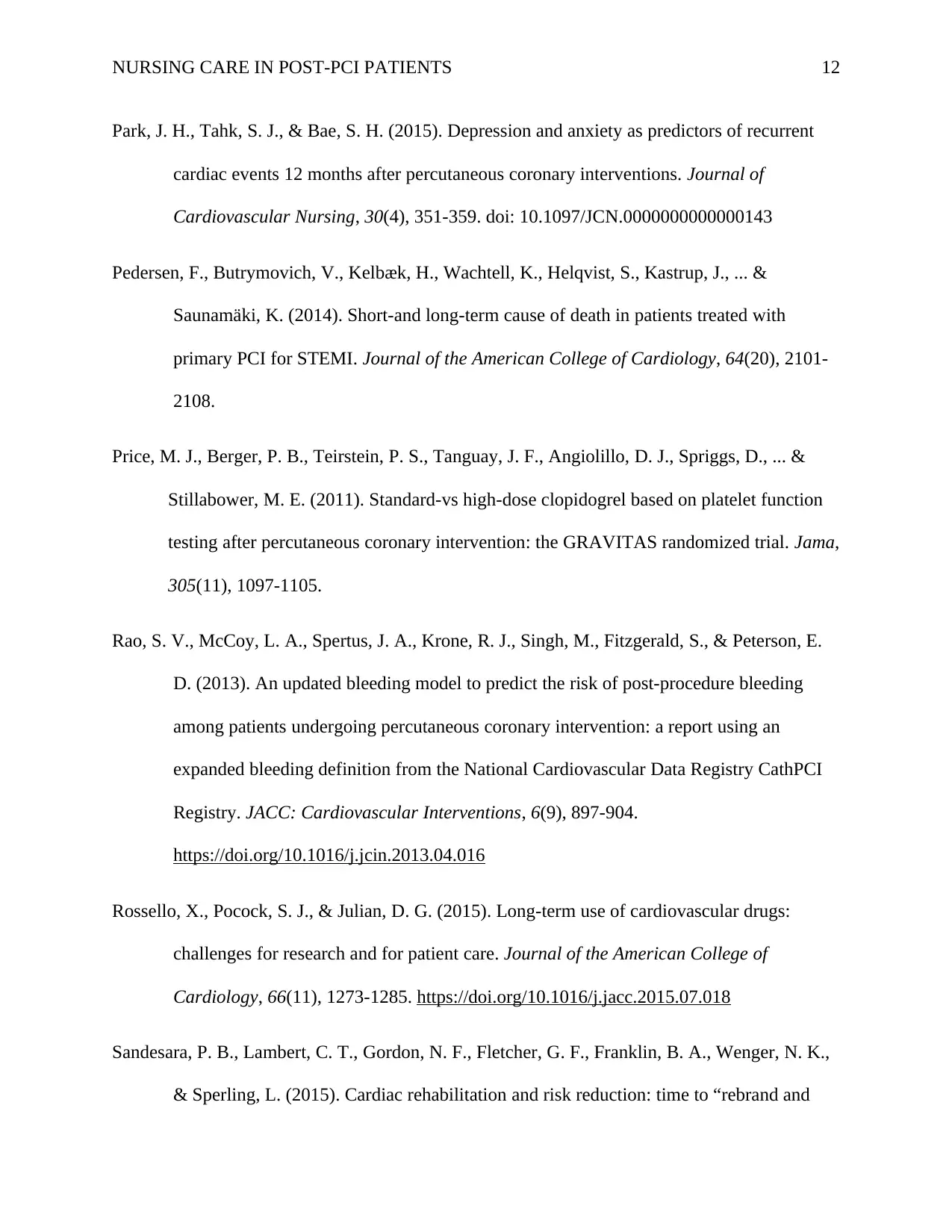
NURSING CARE IN POST-PCI PATIENTS 12
Park, J. H., Tahk, S. J., & Bae, S. H. (2015). Depression and anxiety as predictors of recurrent
cardiac events 12 months after percutaneous coronary interventions. Journal of
Cardiovascular Nursing, 30(4), 351-359. doi: 10.1097/JCN.0000000000000143
Pedersen, F., Butrymovich, V., Kelbæk, H., Wachtell, K., Helqvist, S., Kastrup, J., ... &
Saunamäki, K. (2014). Short-and long-term cause of death in patients treated with
primary PCI for STEMI. Journal of the American College of Cardiology, 64(20), 2101-
2108.
Price, M. J., Berger, P. B., Teirstein, P. S., Tanguay, J. F., Angiolillo, D. J., Spriggs, D., ... &
Stillabower, M. E. (2011). Standard-vs high-dose clopidogrel based on platelet function
testing after percutaneous coronary intervention: the GRAVITAS randomized trial. Jama,
305(11), 1097-1105.
Rao, S. V., McCoy, L. A., Spertus, J. A., Krone, R. J., Singh, M., Fitzgerald, S., & Peterson, E.
D. (2013). An updated bleeding model to predict the risk of post-procedure bleeding
among patients undergoing percutaneous coronary intervention: a report using an
expanded bleeding definition from the National Cardiovascular Data Registry CathPCI
Registry. JACC: Cardiovascular Interventions, 6(9), 897-904.
https://doi.org/10.1016/j.jcin.2013.04.016
Rossello, X., Pocock, S. J., & Julian, D. G. (2015). Long-term use of cardiovascular drugs:
challenges for research and for patient care. Journal of the American College of
Cardiology, 66(11), 1273-1285. https://doi.org/10.1016/j.jacc.2015.07.018
Sandesara, P. B., Lambert, C. T., Gordon, N. F., Fletcher, G. F., Franklin, B. A., Wenger, N. K.,
& Sperling, L. (2015). Cardiac rehabilitation and risk reduction: time to “rebrand and
Park, J. H., Tahk, S. J., & Bae, S. H. (2015). Depression and anxiety as predictors of recurrent
cardiac events 12 months after percutaneous coronary interventions. Journal of
Cardiovascular Nursing, 30(4), 351-359. doi: 10.1097/JCN.0000000000000143
Pedersen, F., Butrymovich, V., Kelbæk, H., Wachtell, K., Helqvist, S., Kastrup, J., ... &
Saunamäki, K. (2014). Short-and long-term cause of death in patients treated with
primary PCI for STEMI. Journal of the American College of Cardiology, 64(20), 2101-
2108.
Price, M. J., Berger, P. B., Teirstein, P. S., Tanguay, J. F., Angiolillo, D. J., Spriggs, D., ... &
Stillabower, M. E. (2011). Standard-vs high-dose clopidogrel based on platelet function
testing after percutaneous coronary intervention: the GRAVITAS randomized trial. Jama,
305(11), 1097-1105.
Rao, S. V., McCoy, L. A., Spertus, J. A., Krone, R. J., Singh, M., Fitzgerald, S., & Peterson, E.
D. (2013). An updated bleeding model to predict the risk of post-procedure bleeding
among patients undergoing percutaneous coronary intervention: a report using an
expanded bleeding definition from the National Cardiovascular Data Registry CathPCI
Registry. JACC: Cardiovascular Interventions, 6(9), 897-904.
https://doi.org/10.1016/j.jcin.2013.04.016
Rossello, X., Pocock, S. J., & Julian, D. G. (2015). Long-term use of cardiovascular drugs:
challenges for research and for patient care. Journal of the American College of
Cardiology, 66(11), 1273-1285. https://doi.org/10.1016/j.jacc.2015.07.018
Sandesara, P. B., Lambert, C. T., Gordon, N. F., Fletcher, G. F., Franklin, B. A., Wenger, N. K.,
& Sperling, L. (2015). Cardiac rehabilitation and risk reduction: time to “rebrand and
⊘ This is a preview!⊘
Do you want full access?
Subscribe today to unlock all pages.

Trusted by 1+ million students worldwide
1 out of 13
Related Documents
Your All-in-One AI-Powered Toolkit for Academic Success.
+13062052269
info@desklib.com
Available 24*7 on WhatsApp / Email
![[object Object]](/_next/static/media/star-bottom.7253800d.svg)
Unlock your academic potential
Copyright © 2020–2025 A2Z Services. All Rights Reserved. Developed and managed by ZUCOL.





